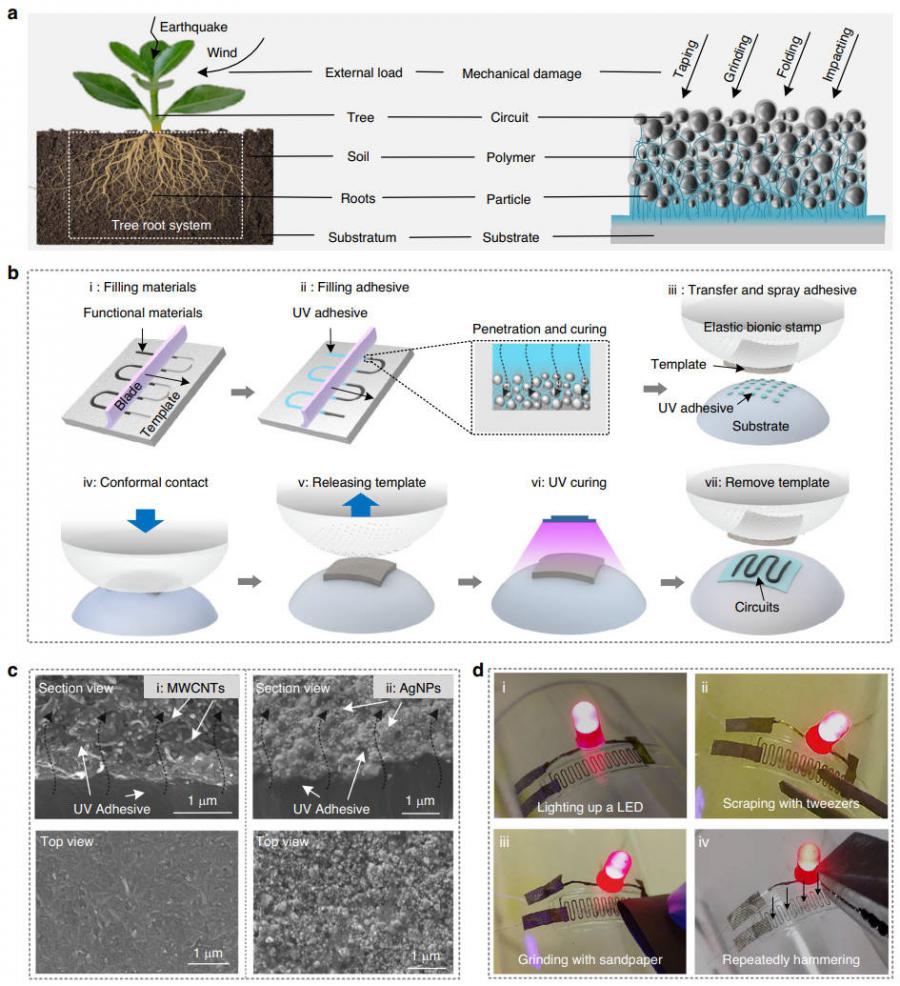
From roots to rugged circuits: the future of flexible electronics unveiled
GA, UNITED STATES, February 1, 2025 /EINPresswire.com/ -- A printing technology, inspired by the resilience of tree root systems, is set to redefine the future of conformal electronics. This innovation addresses long-standing challenges related to the mechanical stability and resolution of circuits on irregular surfaces, particularly in smart robotics and advanced sensing systems. By improving both the durability and precision of electronic circuits, this new method promises to withstand extreme conditions—such as high temperatures and mechanical stress—thereby vastly expanding the potential applications and reliability of conformal electronics.
Conformal electronics, which are crucial for applications like smart skins and robotics, have long struggled with significant mechanical and thermal vulnerabilities. Traditional printing methods often produce circuits that are prone to tearing, cracking, and other forms of damage, limiting their performance and dependability. Additionally, creating high-resolution circuits with a wide variety of materials remains a complex task, necessitating the development of innovative fabrication techniques to address both mechanical durability and precision in electronic circuits.
Researchers at Xi'an Jiaotong University have developed a cutting-edge solution to these challenges. In a study (DOI: 10.1038/s41378-024-00840-z) published on January 6, 2024, in Microsystems & Nanoengineering, the team introduced the Template-Constrained Additive (TCA) printing technology. This new approach, inspired by the strength of tree root systems, enhances the mechanical robustness of circuits, enabling them to withstand extreme conditions, including temperatures up to 350°C and intense mechanical wear. The TCA technology also achieves high-resolution printing capabilities, with a precision of up to 300 nm, and supports a diverse range of materials, such as P(VDF-TrFE), MWCNTs, and AgNPs.
The TCA printing technology revolutionizes the fabrication of conformal circuits by embedding adhesive into functional materials, which creates a deep interlocking interface that significantly strengthens the mechanical integrity of the circuits. This enables the circuits to retain their electrical performance, even under extreme environmental conditions. The method also supports the creation of multi-layered, self-aligned circuits, overcoming many of the limitations of traditional printing techniques. As a testament to its potential, the study successfully demonstrated the fabrication of conformal temperature and humidity sensors, as well as ultra-thin energy storage systems—applications that underscore TCA printing’s vast potential to reshape the future of electronics.
Dr. Jinyou Shao, a co-author of the study and the group leader, emphasized the significance of this innovation, stating, “The TCA printing technology represents a major leap forward in the field of conformal electronics. By drawing inspiration from nature, we’ve developed a solution that not only enhances the durability of electronic circuits but also achieves remarkable precision and versatility. This makes it ideal for a wide array of applications, from wearables to advanced robotics.”
The implications of TCA printing are vast. With its ability to create durable and high-resolution conformal circuits, this technology is poised to revolutionize fields such as autonomous vehicles, where sensors must endure harsh environmental conditions. In robotics, the technology promises to enhance the performance and reliability of electronic components integrated into robotic skins and joints. Beyond these, TCA printing opens the door to integrating electronics into everyday objects like wearable devices and smart textiles. Its flexibility and precision also have the potential to drive advancements in aerospace and biomedical electronics, where both durability and exactitude are crucial. The future of conformal electronics looks brighter than ever, thanks to this innovative technology.
DOI
10.1038/s41378-024-00840-z
Original Source URL
https://doi.org/10.1038/s41378-024-00840-z
Funding information
This research was supported by the National Key Research and Development Project (No. 2021YFB2011500 (XL)), National Nature Science Foundation of China (No.52025055(JS)), National Nature Science Foundation of China (No.51975467(XL)), Joint Fund Project-Enterprise-Shaanxi Coal Joint Fund Project (NO.2021JLM-42 (XL)). Key Research and Development Program of Shaanxi (No. 2022GXLH-01-12).
Lucy Wang
BioDesign Research
email us here
Distribution channels: Science, Technology
Legal Disclaimer:
EIN Presswire provides this news content "as is" without warranty of any kind. We do not accept any responsibility or liability for the accuracy, content, images, videos, licenses, completeness, legality, or reliability of the information contained in this article. If you have any complaints or copyright issues related to this article, kindly contact the author above.
Submit your press release
